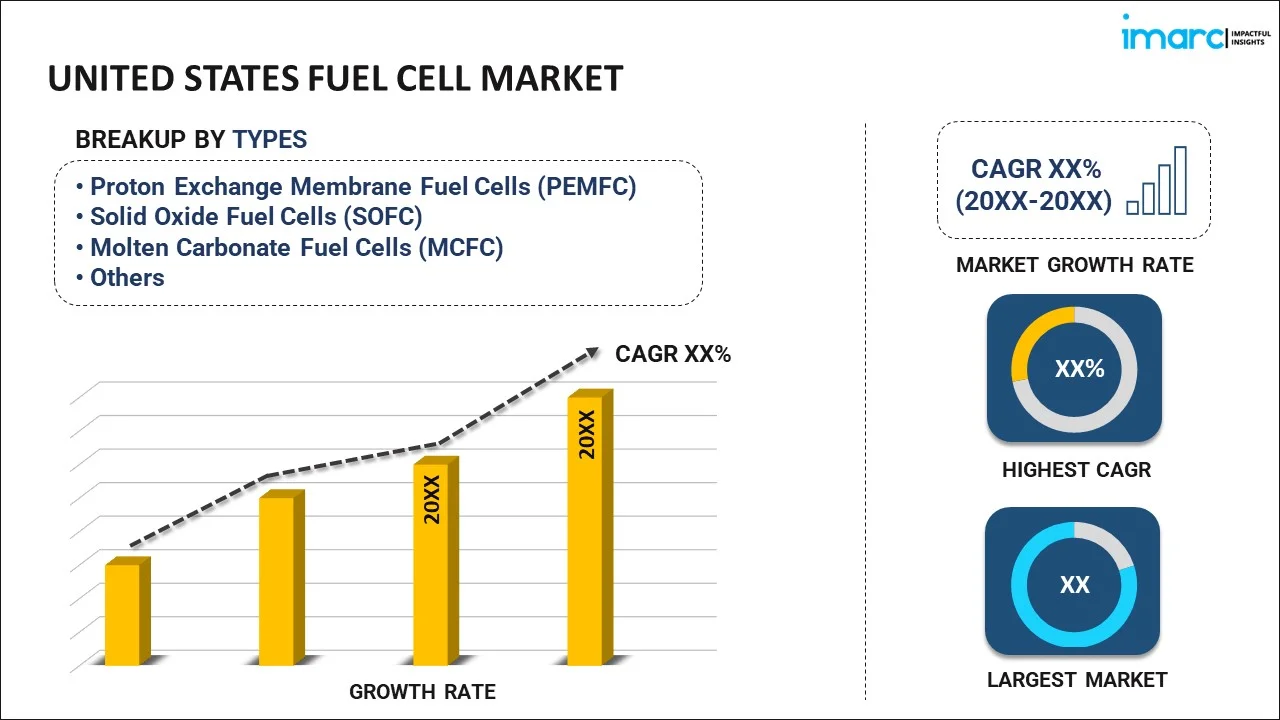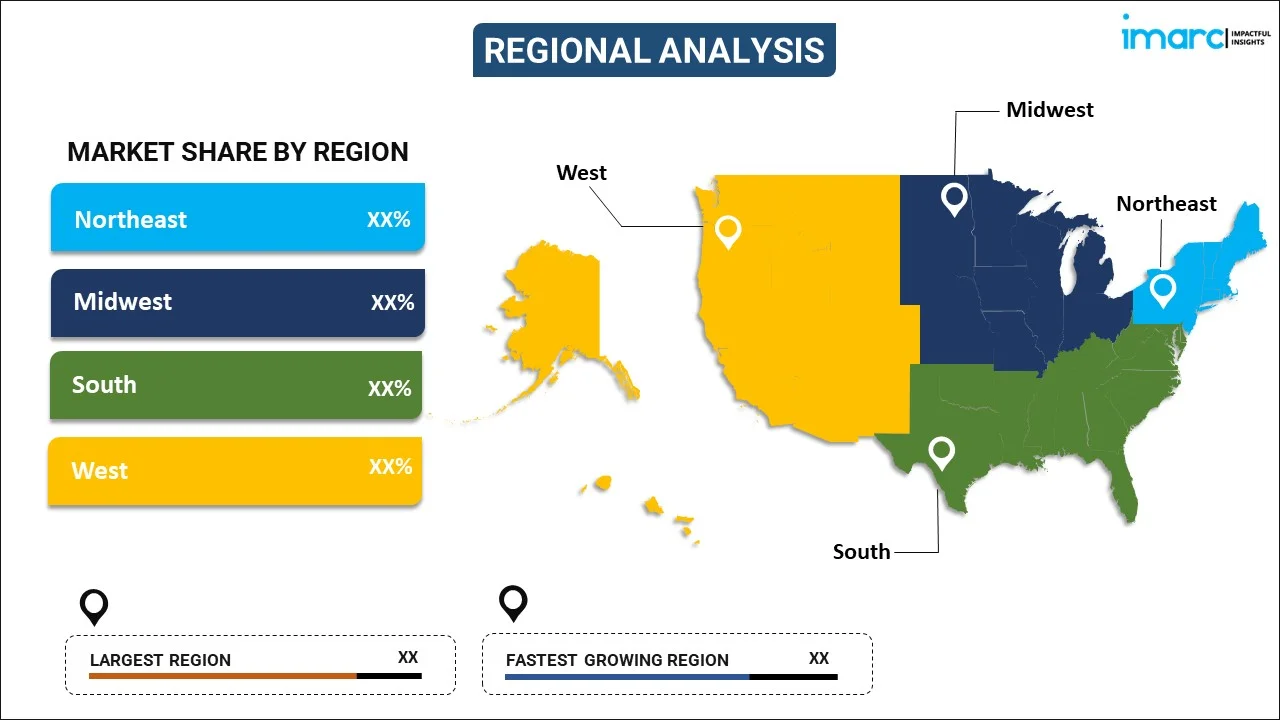
United States Fuel Cell Market Report by Type (Proton Exchange Membrane Fuel Cells (PEMFC), Solid Oxide Fuel Cells (SOFC), Molten Carbonate Fuel Cells (MCFC), Direct Methanol Fuel Cells (DMFC), Phosphoric Acid Fuel Cells (PAFC), and Others), Application (Stationary, Transportation, Portable), and Region 2025-2033
Market Overview:
The United States fuel cell market size reached USD 1,629.0 Million in 2024. Looking forward, IMARC Group expects the market to reach USD 7,698.7 Million by 2033, exhibiting a growth rate (CAGR) of 18.84% during 2025-2033. The increasing focus on reducing carbon emissions, the sudden shift towards sustainability, rapid technological advancements in fuel cell design and materials, and the integration of fuel cells with renewable energy sources represent some of the key factors driving the United States fuel cell market share.
|
Report Attribute
|
Key Statistics
|
|---|---|
|
Base Year
|
2024 |
|
Forecast Years
|
2025-2033
|
|
Historical Years
|
2019-2024
|
| Market Size in 2024 | USD 1,629.0 Million |
| Market Forecast in 2033 | USD 7,698.7 Million |
| Market Growth Rate (2025-2033) | 18.84% |
United States Fuel Cell Market Analysis:
- Major Drivers: Increasing government regulations and incentives for clean energy deployment propel major market growth. Increased corporate sustainability efforts and carbon neutrality targets boost fuel cell technology adoption across various industrial applications across the country.
- Key Market Trends: United States fuel cell market growth shows growing alignment with renewable energy equipment and intelligent grid infrastructure. Innovative hydrogen generation techniques and growing refueling networks increase market accessibility and commercial viability dramatically.
- Market Challenges: Significant initial high capital expenditures and sparse hydrogen infrastructure pose major hindrances to broad-based adoption. Fuel cell technical complexity in maintenance and shortage of competent technicians inhibit market penetration in many different industries.
- Market Opportunities: Federal policies on clean energy and state incentives provide favorable investment climate for fuel cell installation. Increasing demand for backup power systems and off-grid uses offers lucrative expansion prospects.
A fuel cell refers to a device that generates electricity through a chemical reaction involving hydrogen and oxygen, without combustion. It is available in several types, including polymer electrolyte membrane (PEM), solid oxide, alkaline, molten carbonate, and phosphoric acid fuel cells, each differing in materials used and operational temperature. Fuel cells are manufactured using catalysts, electrolytes, and various metals for structural components. They find applications in a wide range of sectors, including transportation, stationary power generation, portable power, space missions, submarines, forklifts, telecommunications, residential power, emergency services, and hydrogen refueling stations. Fuel cells offer high efficiency, reliability, scalability, low emissions, quiet operation, minimal maintenance, rapid refueling, long lifespan, flexibility, and reduced dependency on fossil fuels. Moreover, they are lauded for their environmental friendliness, operational cost savings, energy security, space efficiency, versatility, adaptability, and contribution to a sustainable energy future.
United States Fuel Cell Market Trends:
Advanced Hydrogen Production Technologies
The American fuel cell industry is seeing tremendous progress in hydrogen production methods, especially green hydrogen production using renewable energy resources. Advancements in electrolysis technology have minimized production costs and maximized efficiency rates, and hence are making fuel cells economically feasible for commercial use. Large energy corporations are investing heavily in solar- and wind-powered electrolysis plants at scale to produce carbon-free hydrogen. This movement aligns with the overall decarbonization objectives while establishing a green supply chain for fuel cell usage. Furthermore, new production methods such as thermochemical water splitting and biological hydrogen production is driving the United States fuel cell market analysis. Funding from the government and private stakeholders is boosting research and development (R&D) in this area with promised additional cost savings and increased production capabilities. Development of hydrogen hubs at strategic sites is enabling infrastructure development and realizing economies of scale that can be enjoyed by the entire fuel cell industry.
Integration with Smart Grid Systems
Fuel cell technology is being more and more combined with smart grid infrastructure to increase energy management and grid stability. This development entails installing fuel cells as distributed energy resources that can offer primary power and grid services like frequency regulation and peak shaving. Advanced control systems make real-time communication possible between fuel cells and grid operators, maximizing energy dispatch according to demand patterns and renewable energy availability. The integration enhances grid reliability by delivering back-up power in case of interruptions and offloading load from transmission wires. Fuel cells' potential to mitigate intermittency issues related to renewable energy sources is being noticed by utility operators. Smart grid integration also facilitates demand response initiatives wherein fuel cells can modify their operation as a function of grid conditions and price signals. This synergic relationship between fuel cells and smart grids is generating new revenue streams for fuel cell operators while offering beneficial grid services. The trend is underpinned by federal efforts encouraging grid modernization and energy security improvement.
Commercial Vehicle Fleet Adoption
The commercial transport industry is propelling high United States fuel cells demand, especially for heavy-duty use where battery electric cars are constrained. Port operators, logistics firms, and fleet operators are increasingly using fuel cell trucks, buses, and forklifts to achieve emission reduction requirements while ensuring operational productivity. Fuel cells are more superior in refueling time, range, and payload capacity compared to battery equivalents when used in commercial purposes. Major manufacturers are introducing commercial fuel cell vehicles with higher performance and competitive total cost of ownership. The trend is boosted by state and federal incentives targeting commercial fleet electrification, such as grants, tax credits, and low-interest financing. California's Advanced Clean Trucks Rule and regulatory initiatives in other states are requiring emissions reductions that promote fuel cell adoption. Infrastructure build-out is keeping pace with this demand, with hydrogen fueling stations being placed strategically along freight routes and in industrial parks to facilitate commercial use.
United States Fuel Cell Market Segmentation:
IMARC Group provides an analysis of the key trends in each segment of the market, along with forecasts at the country level for 2025-2033. Our report has categorized the market based on type and application.
Type Insights:

To get more information on this market, Request Sample
- Proton Exchange Membrane Fuel Cells (PEMFC)
- Solid Oxide Fuel Cells (SOFC)
- Molten Carbonate Fuel Cells (MCFC)
- Direct Methanol Fuel Cells (DMFC)
- Phosphoric Acid Fuel Cells (PAFC)
- Others
The report has provided a detailed breakup and analysis of the market based on the type. This includes proton exchange membrane fuel cells (PEMFC), solid oxide fuel cells (SOFC), molten carbonate fuel cells (MCFC), direct methanol fuel cells (DMFC), phosphoric acid fuel cells (PAFC), and others.
Application Insights:
- Stationary
- Transportation
- Portable
A detailed breakup and analysis of the market based on the application have also been provided in the report. This includes stationary, transportation, and portable.
Regional Insights:

- Northeast
- Midwest
- South
- West
The report has also provided a comprehensive analysis of all the major regional markets, which include Northeast, Midwest, South, and West.
Competitive Landscape:
The market research report has also provided a comprehensive analysis of the competitive landscape in the market. Competitive analysis such as market structure, key player positioning, top winning strategies, competitive dashboard, and company evaluation quadrant has been covered in the report. Also, detailed profiles of all major companies have been provided.
Recent News and Development:
- In August 2025, bold and adventurous flavors are driving product launches, fueled by social media influence, especially TikTok, which shapes Gen Z preferences. Viral, “Instagram-worthy” flavors quickly reach store shelves, with creators amplifying trends. Consumers are drawn to nostalgic and limited-time offerings, while global flavors like Gochujang, chili crisp, and chili lime gain traction. The year’s top three rising flavors reflect this blend of cultural mashups, innovation, and digital-driven demand.
- In July 2025, Mars’ Ben’s Original™ launched new Single-Serve Rice Cups and expanded Street Food entrees in the U.S. and Canada, catering to busy consumers seeking tasty, healthy, and convenient meals. With 75% of U.S. adults eating on-the-go, the microwave-ready cups offer quick options in Jasmine, Spanish Style, Fried Rice, and Roasted Chicken flavors. These innovations reflect Mars’ commitment to accessible, flavorful mealtime solutions while modernizing a trusted 75-year-old brand.
- In April 2024, Walmart has launched Bettergoods, its largest private food brand in 20 years, introducing 300 products focused on plant-based, gluten-free, and adventurous flavors. Aimed at attracting higher-income shoppers, the line features items like oat milk ice cream, bronze cut pasta, and jalapeño chowder at affordable prices. This strategic expansion reinforces Walmart’s dominance in U.S. grocery retail, emphasizing unique, spicy, and health-conscious options to meet evolving consumer preferences.
United States Fuel Cell Market Report Coverage:
| Report Features | Details |
|---|---|
| Base Year of the Analysis | 2024 |
| Historical Period | 2019-2024 |
| Forecast Period | 2025-2033 |
| Units | Million USD |
| Scope of the Report | Exploration of Historical Trends and Market Outlook, Industry Catalysts and Challenges, Segment-Wise Historical and Future Market Assessment:
|
| Types Covered | Proton Exchange Membrane Fuel Cells (PEMFC), Solid Oxide Fuel Cells (SOFC), Molten Carbonate Fuel Cells (MCFC), Direct Methanol Fuel Cells (DMFC), Phosphoric Acid Fuel Cells (PAFC), Others |
| Applications Covered | Stationary, Transportation, Portable |
| Regions Covered | Northeast, Midwest, South, West |
| Customization Scope | 10% Free Customization |
| Post-Sale Analyst Support | 10-12 Weeks |
| Delivery Format | PDF and Excel through Email (We can also provide the editable version of the report in PPT/Word format on special request) |
Key Benefits for Stakeholders:
- IMARC’s industry report offers a comprehensive quantitative analysis of various market segments, historical and current market trends, market forecasts, and dynamics of the United States fuel cell market from 2019-2033.
- The research report provides the latest information on the market drivers, challenges, and opportunities in the United States fuel cell market.
- Porter's five forces analysis assist stakeholders in assessing the impact of new entrants, competitive rivalry, supplier power, buyer power, and the threat of substitution. It helps stakeholders to analyze the level of competition within the United States fuel cell industry and its attractiveness.
- Competitive landscape allows stakeholders to understand their competitive environment and provides an insight into the current positions of key players in the market.
Key Questions Answered in This Report
The fuel cell market in the United States was valued at USD 1,629.0 Million in 2024.
The United States fuel cell market is projected to exhibit a CAGR of 18.84% during 2025-2033, reaching a value of USD 7,698.7 Million by 2033.
The United States fuel cell market is driven by increasing emphasis on clean energy solutions, government incentives supporting hydrogen and fuel cell adoption, and rising demand for efficient power generation. Expanding applications in transportation, stationary power, and portable devices further accelerate market growth, aligning with the nation’s decarbonization goals.
Need more help?
- Speak to our experienced analysts for insights on the current market scenarios.
- Include additional segments and countries to customize the report as per your requirement.
- Gain an unparalleled competitive advantage in your domain by understanding how to utilize the report and positively impacting your operations and revenue.
- For further assistance, please connect with our analysts.
 Request Customization
Request Customization
 Speak to an Analyst
Speak to an Analyst
 Request Brochure
Request Brochure
 Inquire Before Buying
Inquire Before Buying




.webp)




.webp)












